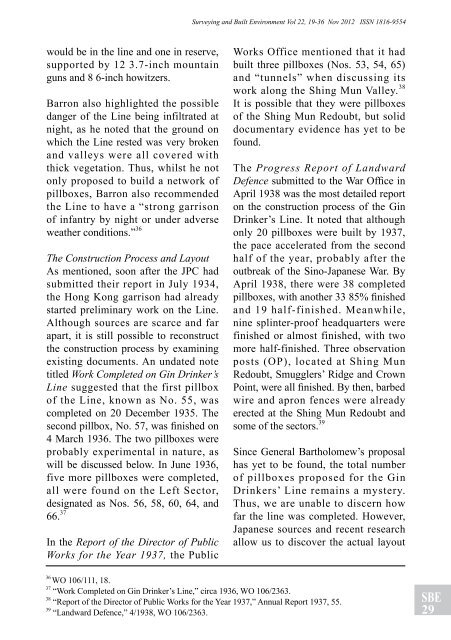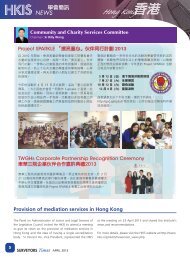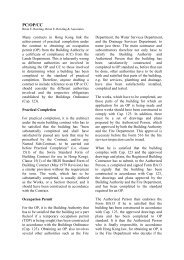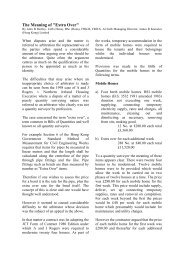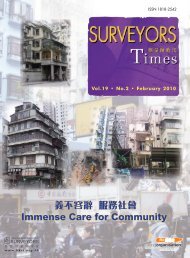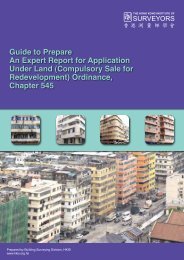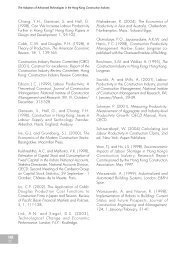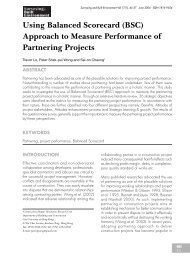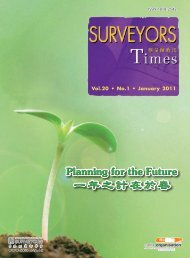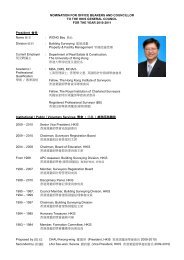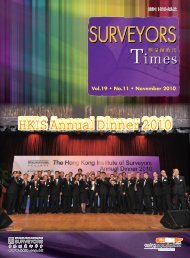Surveying & Built Environment Vol. 22 Issue 1 (December 2012)
Surveying & Built Environment Vol. 22 Issue 1 (December 2012)
Surveying & Built Environment Vol. 22 Issue 1 (December 2012)
You also want an ePaper? Increase the reach of your titles
YUMPU automatically turns print PDFs into web optimized ePapers that Google loves.
would be in the line and one in reserve,<br />
supported by 12 3.7-inch mountain<br />
guns and 8 6-inch howitzers.<br />
Barron also highlighted the possible<br />
danger of the Line being infiltrated at<br />
night, as he noted that the ground on<br />
which the Line rested was very broken<br />
and valleys were all covered with<br />
thick vegetation. Thus, whilst he not<br />
only proposed to build a network of<br />
pillboxes, Barron also recommended<br />
the Line to have a “strong garrison<br />
of infantry by night or under adverse<br />
weather conditions.” 36<br />
The Construction Process and Layout<br />
As mentioned, soon after the JPC had<br />
submitted their report in July 1934,<br />
the Hong Kong garrison had already<br />
started preliminary work on the Line.<br />
Although sources are scarce and far<br />
apart, it is still possible to reconstruct<br />
the construction process by examining<br />
existing documents. An undated note<br />
titled Work Completed on Gin Drinker’s<br />
Line suggested that the first pillbox<br />
of the Line, known as No. 55, was<br />
completed on 20 <strong>December</strong> 1935. The<br />
second pillbox, No. 57, was finished on<br />
4 March 1936. The two pillboxes were<br />
probably experimental in nature, as<br />
will be discussed below. In June 1936,<br />
five more pillboxes were completed,<br />
all were found on the Left Sector,<br />
designated as Nos. 56, 58, 60, 64, and<br />
66. 37<br />
In the Report of the Director of Public<br />
Works for the Year 1937, the Public<br />
<strong>Surveying</strong> and <strong>Built</strong> <strong>Environment</strong> <strong>Vol</strong> <strong>22</strong>, 19-36 Nov <strong>2012</strong> ISSN 1816-9554<br />
Works Office mentioned that it had<br />
built three pillboxes (Nos. 53, 54, 65)<br />
and “tunnels” when discussing its<br />
work along the Shing Mun Valley. 38<br />
It is possible that they were pillboxes<br />
of the Shing Mun Redoubt, but solid<br />
documentary evidence has yet to be<br />
found.<br />
The Progress Report of Landward<br />
Defence submitted to the War Office in<br />
April 1938 was the most detailed report<br />
on the construction process of the Gin<br />
Drinker’s Line. It noted that although<br />
only 20 pillboxes were built by 1937,<br />
the pace accelerated from the second<br />
half of the year, probably after the<br />
outbreak of the Sino-Japanese War. By<br />
April 1938, there were 38 completed<br />
pillboxes, with another 33 85% finished<br />
and 19 half-finished. Meanwhile,<br />
nine splinter-proof headquarters were<br />
finished or almost finished, with two<br />
more half-finished. Three observation<br />
posts (OP), located at Shing Mun<br />
Redoubt, Smugglers’ Ridge and Crown<br />
Point, were all finished. By then, barbed<br />
wire and apron fences were already<br />
erected at the Shing Mun Redoubt and<br />
some of the sectors. 39<br />
Since General Bartholomew’s proposal<br />
has yet to be found, the total number<br />
of pillboxes proposed for the Gin<br />
Drinkers’ Line remains a mystery.<br />
Thus, we are unable to discern how<br />
far the line was completed. However,<br />
Japanese sources and recent research<br />
allow us to discover the actual layout<br />
36<br />
WO 106/111, 18.<br />
37<br />
“Work Completed on Gin Drinker’s Line,” circa 1936, WO 106/2363.<br />
38<br />
“Report of the Director of Public Works for the Year 1937,” Annual Report 1937, 55.<br />
39<br />
“Landward Defence,” 4/1938, WO 106/2363.<br />
SBE<br />
29


